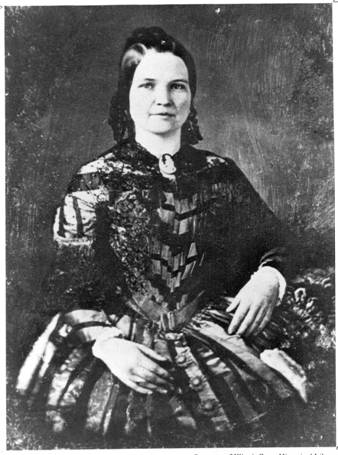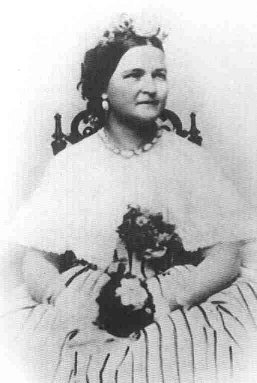AN OVERVIEW OF MARY TODD LINCOLN'S LIFE
|
|
Mary Ann Todd was born on December 13, 1818, in Lexington, Kentucky. Mary was one of seven children born to Robert S. Todd and his wife, Eliza Parker Todd. The Todds were a prominent family in Lexington. Mary's mother passed away in 1825, and her father remarried the following year.
Mary excelled in school. She appeared in school plays and learned to speak French fluently. Mary was ambitious, scholarly, and an excellent conversationalist.
In 1839 Mary moved to Springfield, Illinois, to live at the home of her older sister, Elizabeth Edwards. Mary, who stood about 5-2, was active and popular in Springfield's society, and she dated people like Stephen A. Douglas and Abraham Lincoln. Lincoln won her heart, and the two were married in 1842. Abraham gave her a wedding ring engraved with the words "Love is Eternal." (It has also been reported that the entire inscription read "A.L. to Mary, Nov. 4, 1842. Love is Eternal.")
Over the next 11 years, the couple had four children. They were Robert (1843-1926), Edward ("Eddie" - 1846-1850), William ("Willie" - 1850-1862), and Thomas ("Tad" - 1853-1871). Sadly, Robert was the only child of the Lincolns to live to adulthood. Mary was known as a very loving and caring mother. She was very devoted to her family.
|
|
|
|
In 1844 the Lincolns bought a home in Springfield at the corner of Eighth and Jackson. Abraham had become a successful attorney and politician. In 1846 he was elected to the U.S. House of Representatives. Mary and the children lived with him in Washington for part of his term. Abraham did not run for an office again, and the family was back together again in Springfield in 1849.
Abraham concentrated on his law practice until 1854 when his mind again turned to politics. In 1856 he received some support for the Republican vice-presidential nomination, and in 1858, he engaged in a well-known series of debates with Stephen A. Douglas. He received the Republican nomination for president in 1860 and was elected over three other candidates in November. In February 1861 the Lincolns left Springfield headed for Washington, D.C. Abraham was inaugurated as the 16th president on March 4, 1861.
As First Lady Mary spent a good deal of time refurbishing the White House. She also made many trips to hospitals to take food, flowers, etc. to injured soldiers. She read to the soldiers, wrote them letters, and once raised $1,000 for the Christmas dinner at a military hospital. Tad often accompanied her on these visits to see the soldiers. (Willie had died in the White House early in 1862; Robert was away at college.) Additionally, Mary provided support for the Contraband Relief Association which helped blacks who came to the North during the Civil War.
|
|
She was opposed to slavery, and she strongly supported her husband's pro-Union policies. On the other hand, Mary received criticism for her numerous shopping sprees and because many of her relatives had chosen to side with the South in the war. Several relatives died fighting for the Confederacy. Mary caused controversy as First Lady; she made both friends and enemies while her husband was president.
On April 9, 1865, General Robert E. Lee surrendered to General Ulysses S. Grant at Appomattox. Five days later Abraham and Mary attended a performance of Our American Cousin at Ford's Theatre. It was that night that John Wilkes Booth shot the president as Mary held his hand during the play. It was a tragedy from which Mary never would recover.
In May of 1865 Mary, Robert, and Tad left Washington to live in Chicago. In 1867 Mary tried to raise some money by selling her old clothes through dealers in New York, but this was unsuccessful. Robert was embarrassed at his mother's behavior. Mary's eldest son was on his way to becoming a successful attorney.
In 1868 Mary and Tad left the United States and lived in Europe until 1871. Tad attended school in Germany. Mary visited several countries during the three-year stay. Her arthritis began acting up in Europe, and Mary sought comfort in health spas.
|
|
|
Tad died in Chicago shortly after the two returned to the United States. Again Mary mourned a loved one. She continued to travel often, and her behavior and irrational fears became an increasing concern to Robert. He began to fear for his mother's well being, and he instigated an insanity hearing. Various witnesses testified to Mary's erratic behavior and habits. A jury of 12 men declared Mary insane. The court admitted that "the disease was of unknown duration; the cause is unknown." Mary spent a little less than four months in a private sanitarium called Bellevue located in Batavia, Illinois.
In September of 1875 Mary went to Springfield to once again live with her sister's family. In 1876 a second jury found her sane. Later she traveled again to Europe and spent most of her time in France. Her health was in a state of decline, and she again visited health spas. She most likely was suffering from undiagnosed diabetes in addition to spinal arthritis and other ailments. She had suffered from migraine headaches for years and years.
Mary returned to the United States in 1880 and again went to the Edwards' home in Springfield to live. She was slowly going blind. Robert visited her in 1881. Mary stayed all by herself in her shaded room in the Edwards' house. Her health continued to deteriorate. On July 16, 1882, Mary passed away at the age of 63. The exact cause of death may have been a stroke. The doctor wrote "paralysis" on the death certificate.
Mary was buried next to her husband in the Lincoln Tomb at Oak Ridge Cemetery in Springfield. She was buried with the ring Abraham had given her in 1842. It was quite thin from wear, but the words "Love is Eternal" were still visible.
|
|
|
This is not a commercial website. None of the photographs and artwork exhibited herein are being sold by the webmaster. Some photographs and artwork are believed to be in the public domain. Any copyrighted photographs and artwork are used in the context of this website strictly for educational, research and historical purposes only, under the "Fair Use" provisions of the Copyright Act, (US CODE: Title 17,107. Limitations on exclusive rights: Fair Use Section 107). Anyone claiming copyright to any of the posted photographs or artwork please inform the webmaster of such and it will be duly noted or removed.
Questions, comments, corrections or suggestions can be sent to R. J. Norton, the creator and maintainer of this site. All text except reprinted articles was written by the webmaster, ©1996-2017. All rights reserved. It is unlawful to copy, reproduce or transmit in any form or by any means, electronic or hard copy, including reproducing on another web page, or in any information or retrieval system without the express written permission of the author. The website was born on December 29, 1996.
Web design by Andrew Patel.
|




